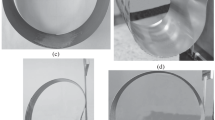Abstract
In this paper it is shown how the long-standing problem of the break-up of a cylindrical interface due to surface tension can be generalized to an arbitrary number of interacting interfaces in an arbitrary configuration. A system of immersed threads starting with two types of configurations is studied, i.e., a system of threads on a row and a system of threads at triangular vertices. From these cases, which are worked out in detail, it becomes clear how the stability of an arbitrary configuration can be determined. The (in)stability of the configuration is discussed in terms of the so-called disturbance growth rate. It turns out that the threads break up in specific phase patterns in which neighbouring threads are either in-phase or out-of-phase. For L threads, in principle 2L phase patterns are possible. However, it is shown that the stability of the system directly follows from L so-called basic phase patterns. Special attention is paid to the special case of threads and fluid having equal viscosity. Then, the growth rate can be calculated analytically using Hankel transformations. An estimate for the growth rate in this case, which turns out to be quite sharp, is derived.
Similar content being viewed by others
References
1._ F. Savart, Memoire sur la Constitution des Veines liquides lancees par des orifices circulaires en mince paroi. Annal. Chim. Phys. 53 (1833) 337–374.
J. Plateau, Sur les figures d'Équilibre d'une masse liquide sans pésanteur. Mémoires de l'Académie Royale de Belgique, nouvelle série 23 (1849) 5.
L. Rayleigh, On the instability of jets. Proc. London Math. Soc. 10 (1878) 4–13.
L. Rayleigh, On the instability of a cylinder of viscous liquid under the capillary force. Phil. Mag. 34 (1892) 145–154.
S. Tomotika, On the instability of a cylindrical thread of a viscous liquid surrounded by another viscous fluid. Proc. R. Soc. London A 150 (1935) 322–337.
S. Tomotika, Breaking up of a drop of viscous liquid immersed in another viscous fluid which is extending at a uniform rate. Proc. R. Soc. London A 153 (1936) 302–318.
B.J. Meister and G.F. Scheele, Generalized solution of the Tomotika stability analysis for a cylindrical jet. AIChE J. 13 (1967) 682–688.
T. Mikami, R.G. Cox and S.G. Mason, Breakup of extending liquid threads. Int. J. Multiphase Flow 2 (1975) 113–138.
D.V. Khakhar and J.M. Ottino, Breakup of liquid threads in linear flows. Int. J. Multiphase Flow 13 (1987) 71–86.
K.O. Mikaelian, Effect of viscosity on Rayleigh-Taylor and Richtmyer-Meshkov instabilities. Phys. Rev. E 47 (1993) 375–383.
K.O. Mikaelian, Rayleigh-Taylor instability in finite-thickness fluids with viscosity and surface tension. Phys. Rev. E 54 (1996) 3676–3680.
J. Eggers, Universal pinching of 3D axisymmetric free-surface flow. Phys. Rev. Lett. 71 (1993) 3458–3460.
J. Eggers, Theory of drop formation. Phys. Fluids 7 (1995) 941–953.
C.M. Kinoshita, H. Teng and S.M. Masutani, A study of the instability of liquid jets and comparison with Tomotika's analysis. Int. J. Multiphase Flow 20 (1994) 523–533.
D.T. Papageorgiou, On the breakup of viscous liquid threads. Phys. Fluids 7 (1995) 1529–1544.
J. Eggers, Nonlinear dynamics and breakup of free surfaces flows. Rev. Mod. Phys. 3 (1997) 865–929.
A.Y. Gunawan, J. Molenaar and A.A.F. van de Ven, In-phase and out-of-phase break-up of two immersed liquid threads under influence of surface tension. Eur. J. Mech. B/Fluids 21 (2002) 399–412.
Y.M.M. Knops, Morphology Development in Polymer Blends: The Hydrodynamic Interaction Between Disintegrating Threads. Eindhoven: TU-Eindhoven (1997) 68pp.
Y.M.M. Knops, J.J.M. Slot, P.H.M. Elemans and M.J.H. Bulters, Simultaneous breakup of multiple viscous threads surrounded by viscous liquid. AIChE J. 47 (2001) 1740–1745.
H.A. Stone and M.P. Brenner, Note on the capillary thread instability for fluids of equal viscosities. J. Fluid Mech. 318 (1996) 373–374.
G.N. Watson, A Treatise on the Theory of Bessel Functions. Cambridge: University Press (1966) 804pp.
H. Widom, Toeplitz matrices. In: I.I. Hirschman, Jr. (ed), MAA Studies in Mathematics. Vol. 3: Studies in Real and Complex Analysis. New Jersey: Prentice-Hall, Inc. (1965) pp. 179–209.
Author information
Authors and Affiliations
Rights and permissions
About this article
Cite this article
Gunawan, A., Molenaar, J. & van de Ven, A. Break-up of a set of liquid threads under influence of surface tension. Journal of Engineering Mathematics 50, 25–49 (2004). https://doi.org/10.1023/B:ENGI.0000042117.09056.ad
Issue Date:
DOI: https://doi.org/10.1023/B:ENGI.0000042117.09056.ad




